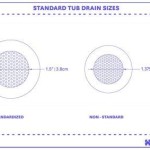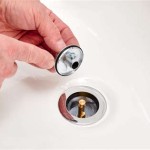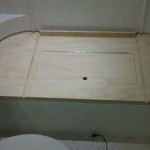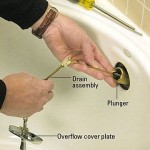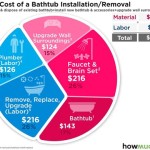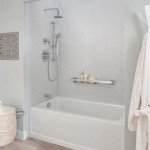Bathtub Shower Enclosure Ideas: Transforming Your Bathing Space
Bathtub shower enclosures are a functional and aesthetic element within a bathroom, serving to contain water during showering and enhance the overall design. Selecting the appropriate enclosure requires careful consideration of space, style, and functionality. The market offers a diverse array of options, each with its own features, benefits, and drawbacks. This article will explore various bathtub shower enclosure ideas, providing insights into different styles, materials, and design considerations to assist in making an informed decision.
Framed vs. Frameless Enclosures
One of the primary distinctions in bathtub shower enclosures lies in whether they are framed or frameless. Framed enclosures, as the name suggests, feature metal framing around the glass panels. This framing provides structural support and often contributes to a more budget-friendly option. The metal frames are typically available in various finishes, such as chrome, brushed nickel, and oil-rubbed bronze, allowing for coordination with existing bathroom fixtures.
Framed enclosures are generally easier to install due to the added support provided by the frame. They also tend to be more effective at preventing water leakage because the frame creates a tighter seal. However, some may find the frame aesthetically less appealing than frameless options. The frame can also accumulate soap scum and mildew over time, requiring regular cleaning and maintenance.
Frameless enclosures, on the other hand, offer a more modern and minimalist aesthetic. They consist of thick glass panels that are typically held in place by minimal hardware. This design creates a more open and spacious feel in the bathroom, as there are fewer visual obstructions. The absence of a frame also simplifies cleaning, reducing the areas where soap scum and mildew can accumulate.
However, frameless enclosures are generally more expensive than framed options. The thicker glass required for structural stability and the more precise installation process contribute to the higher cost. Furthermore, frameless enclosures may require more meticulous sealing to prevent water leakage, and installation is best left to experienced professionals.
Sliding, Hinged, and Bi-Fold Doors
The type of door used in a bathtub shower enclosure significantly impacts its functionality and space utilization. Several door styles are available, each suited to different bathroom layouts and user preferences. The three primary door types are sliding, hinged, and bi-fold.
Sliding doors, also known as bypass doors, consist of two or more glass panels that slide horizontally along a track. This type of door is particularly well-suited for smaller bathrooms where space is limited, as the door does not swing outward into the room. Sliding doors are also a practical choice for households with young children or elderly individuals, as they eliminate the risk of the door swinging open and causing an obstruction.
However, sliding doors can be more difficult to clean than hinged doors, as the overlapping panels create areas where soap scum and mildew can accumulate. The tracks can also become clogged with debris, requiring regular cleaning to ensure smooth operation. Furthermore, the opening created by sliding doors is typically smaller than that of hinged doors.
Hinged doors, also known as swing doors, pivot outward from a hinge. This type of door provides a wide opening and allows for easy access to the bathtub or shower. Hinged doors are typically preferred for larger bathrooms where there is ample space for the door to swing open without obstructing traffic flow. They also offer a more traditional aesthetic, complementing a variety of bathroom styles.
However, hinged doors require sufficient clearance in front of the enclosure to accommodate the swing of the door. In smaller bathrooms, this can be a significant limitation. Furthermore, hinged doors may pose a safety hazard if they swing open unexpectedly, potentially causing injury. Care must be taken to ensure that the door is securely latched when not in use.
Bi-fold doors, also known as folding doors, consist of two or more panels that fold inward when opened. This type of door offers a compromise between the space-saving benefits of sliding doors and the wide opening of hinged doors. Bi-fold doors are particularly well-suited for bathrooms where space is limited but a wider opening is desired.
However, bi-fold doors can be more complex to install than sliding or hinged doors. The folding mechanism requires precise alignment and adjustment to ensure smooth operation. Furthermore, bi-fold doors may be more prone to wear and tear than other door types, as the folding mechanism is subject to repeated stress.
Glass Options and Design Considerations
The type of glass used in a bathtub shower enclosure significantly impacts its appearance, safety, and maintenance requirements. Several glass options are available, each with its own unique characteristics. The primary glass types used in bathtub shower enclosures are clear glass, frosted glass, and textured glass.
Clear glass offers a clean and modern aesthetic, allowing for maximum light transmission and visibility. This type of glass creates a spacious and open feel in the bathroom, making it particularly well-suited for smaller spaces. Clear glass also showcases the tile work and fixtures within the shower, enhancing the overall design.
However, clear glass requires frequent cleaning to maintain its pristine appearance. Water spots, soap scum, and fingerprints are readily visible on clear glass, necessitating regular maintenance. Furthermore, clear glass offers minimal privacy, which may be a concern for some users.
Frosted glass provides a greater degree of privacy compared to clear glass. The frosted surface obscures the view into the shower, making it well-suited for shared bathrooms or for individuals who prefer more privacy. Frosted glass also helps to diffuse light, creating a softer and more ambient atmosphere in the bathroom.
However, frosted glass can be more difficult to clean than clear glass. The textured surface can trap dirt and soap scum, requiring more thorough cleaning. Furthermore, frosted glass may reduce the amount of light transmitted into the shower, potentially making it feel darker.
Textured glass offers a variety of designs, ranging from subtle patterns to more elaborate motifs. This type of glass can add visual interest and character to the bathroom, complementing a variety of design styles. Textured glass also provides a degree of privacy, depending on the specific pattern.
However, textured glass can be more expensive than clear or frosted glass. The manufacturing process is more complex, and the availability of different patterns may be limited. Furthermore, textured glass can be more difficult to clean than smooth glass, as the patterns can trap dirt and soap scum.
Beyond the type of glass, design considerations also play a crucial role in selecting a bathtub shower enclosure. The height of the enclosure, the shape of the enclosure, and the placement of the hardware all contribute to the overall aesthetic and functionality of the enclosure. The height of the enclosure should be sufficient to prevent water from splashing out, while also maintaining adequate ventilation. The shape of the enclosure should complement the shape of the bathtub and the layout of the bathroom. The placement of the hardware should be both functional and aesthetically pleasing, ensuring ease of use and enhancing the overall design.
In addition to these considerations, the choice of showerhead and faucet can also impact the overall design of the bathtub shower enclosure. A rainfall showerhead can create a luxurious and spa-like experience, while a handheld showerhead can provide added flexibility and convenience. The faucet should be chosen to complement the style of the enclosure and the other bathroom fixtures.
Ultimately, the ideal bathtub shower enclosure will depend on individual preferences, budget constraints, and the specific characteristics of the bathroom. By carefully considering the various options and design considerations, it is possible to select an enclosure that is both functional and aesthetically pleasing, transforming the bathing space into a relaxing and inviting retreat.

Pin On Master Down

Contemporary Bathroom Tub Shower Bathtub Combo

8 Bathtub And Shower Combo Ideas The Family Handyman

Luxurious Walk In Showers Shower Ideas

Shower Enclosure Ideas For Modern Bathrooms

8 Bathtub And Shower Combo Ideas The Family Handyman

6 Intriguing Design Ideas For Custom Glass Shower Enclosures

Custom Frameless Glass Shower Enclosure

8 Bathtub And Shower Combo Ideas The Family Handyman

Bathrooms With Glass Shower Enclosures Door Ideas
Related Posts

